The Best Free Firewall Software [January 2021]
![The Best Free Firewall Software [January 2021]](https://www.techjunkie.com/wp-content/uploads/2017/07/The-best-free-firewall-software-to-keep-you-safe-in-20171-1280x720.png)
Just as you wouldn’t leave home for work without locking your door, you shouldn’t use a device on the internet without securing it first. Firewall software is just one way to do that, but it’s certainly one of the strongest. While a firewall is not a get out of jail free card that guarantees your safety online, it will help protect you when you’re browsing the web. Your firewall forms part of the defense your computer relies on everyday to keep you, your computer, and your information safe. Combined with a router-based firewall, good internet habits, and a decent antivirus program, a firewall will help keep you safe while online.
You’ll find firewall software in both free and paid forms, but that doesn’t mean you’re held hostage until you pull out your wallet. While these security companies would love you to think otherwise, the level of protection offered by both free and paid tiers of firewalls are often similar, negating the need to pay for your online security. Paid firewalls often include additional software features in your package, including premium support, antivirus software, and other bonuses. Still, typically, if you’re just looking for a basic firewall, the free versions are the better options for most people.
In this guide, we’ll be concentrating on computers—specifically, on Windows computers. Smartphones have walled gardens that help mitigate the risks of browsing without a firewall (especially on iOS), while macOS has a built-in firewall that makes it easy to stay safe online. As long as you have enabled the default firewall in Mac OS, you have enough protection already. Windows does come with a built-in firewall, but it does not currently monitor outgoing traffic which is a big security flaw. That’s why the third-party firewall market is so buoyant.
So, what are the best free firewalls available in 2021? Let’s dive in—along with a bonus look at what you need from a firewall.
Our Recommendation
Comodo Firewall
Comodo Firewall is my firewall of choice. I have it installed on all of my computers and on my phone. It provides a good level of protection, doesn’t get in the way, offers HIPS protection, sandboxing, a game mode and configurable rules. For a free firewall, there is a lot of utility in this program.
The installer may be quite large but the program itself is light on resources. Make sure to opt out of the browser and search engine change when installing though. Comodo runs a widget in the top right of your screen. You can turn this off in Settings if you wish.
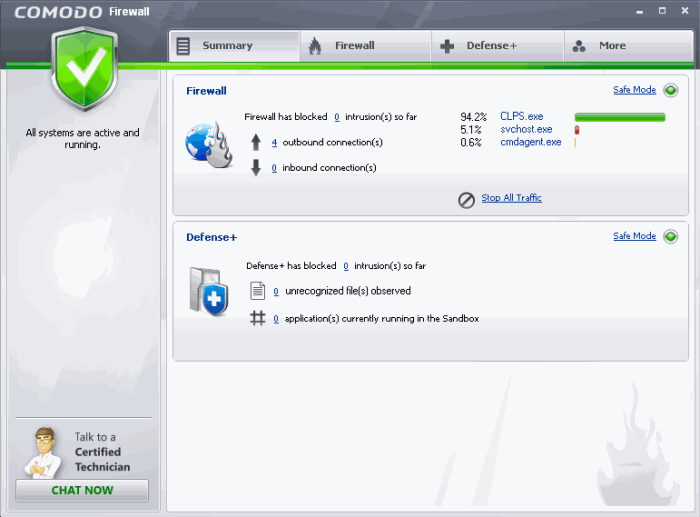
Runner Up
ZoneAlarm Free Firewall
ZoneAlarm Free Firewall used to be my firewall of choice until the newer version of Comodo came out. ZoneAlarm is light, easy to use and fully featured. It is one of the most popular Windows firewalls around and offers a good level of protection at no cost.
ZoneAlarm has an added benefit of a live connection to DefenseNet. This is a live database of real-time threats that can alert your firewall to emerging attacks. If you use the internet a lot, or use public Wi-Fi, this is a great feature.
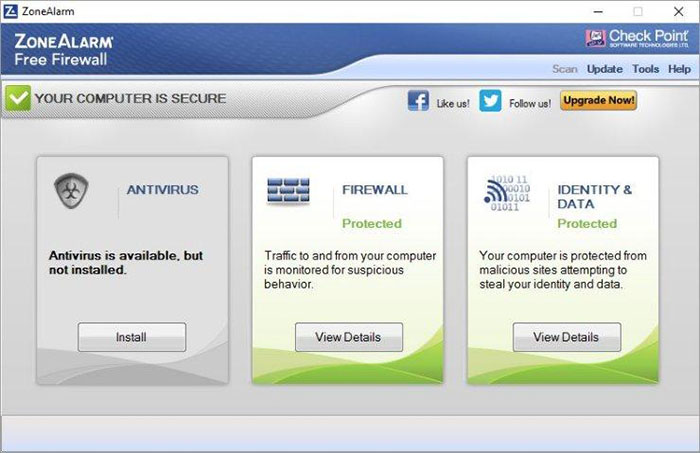
Everyone Else

Emsisoft Internet Security
Emsisoft Internet Security is another free firewall program that offers credible protection at no cost. Less well-known than Comodo or ZoneAlarm but no less proficient, this program used to be known as Online Armor before being changed. The program is light on resources and offers inbound and outbound traffic monitoring.
The UI is simple and uncluttered, there are varying levels of protection depending on how paranoid you are or how much you use the internet. Reviews of Emsisoft Internet Security seem very positive too. This is the only firewall I haven’t used so you will have to try it yourself to see how it works.
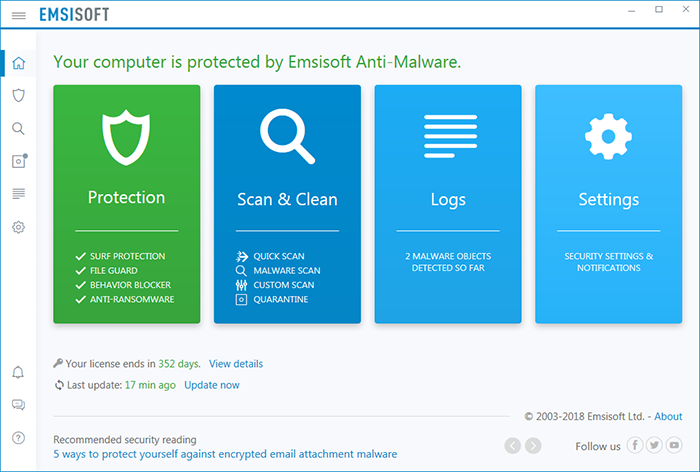
Privatefirewall
At first glance, Privatefirewall looks like something out of the 1990s. The website is very low tech and the interface of the program itself isn’t much better. However, once you get past that, the program is very good indeed. It has some good features, high levels of protection and a simple traffic blocking command for all internet traffic.
Ease of use is at the heart of this free firewall program and once installed, you will quickly begin bending it to your will and blocking programs. Despite first impressions, Privatefirewall is a very competent program and one I have used extensively.
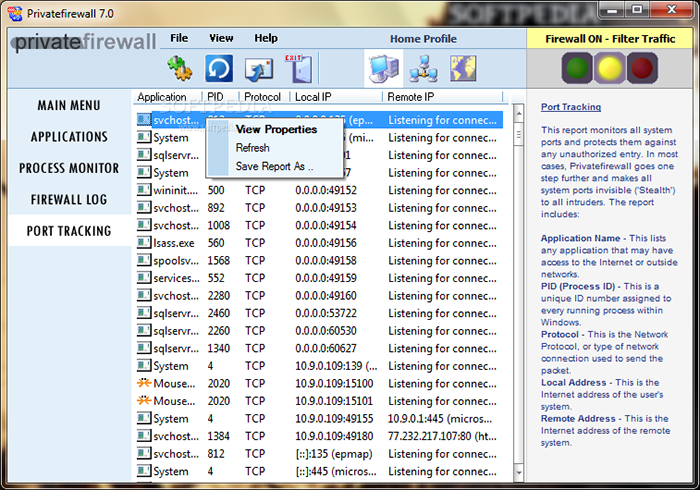

TinyWall
TinyWall is my final recommendation for free firewall software to keep you safe. It is a little different from the others in that it isn’t actually a firewall at all. TinyWall is a hardener for Windows Firewall. That means it is designed to make the built-in firewall more usable, more controllable and more powerful.
I have used TinyWall a lot and if you already have a firewall on your router, is a good option for an extra layer of protection. It still doesn’t monitor outgoing connections but strengthens the default protections within Windows Firewall to credible levels.
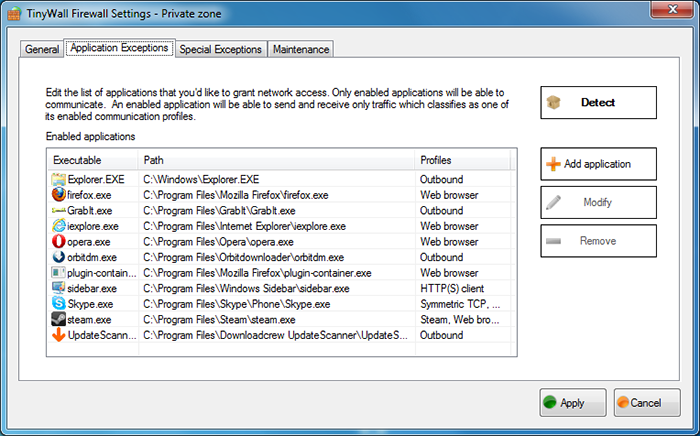
***
Why Not Use Windows Firewall?
The argument about the quality and protection offered by Windows Firewall rages on and will likely do so for many years to come. None of this guide is here to say that Windows Firewall doesn’t do a good job—it does, especially in later Windows 10 updates, with excellent levels of inbound protection. However, by default, Windows Firewall allows all outbound traffic unless you specifically create a rule to control it. That means any malware or Trojan that has found its way onto your computers has free rein to communicate with its host server and send it all your details. So, although Windows Firewall is totally usable, it’s a good idea to supplement it with something else.
How Does a Firewall Work?
Understanding how firewalls work isn’t necessary to use the protections employed by the software, but if you’re curious, they’re actually surprisingly simple. In the real world, firewalls are structures that stand between people and fire. Think fireproof walls between your house and garage. Think those wide spaces of cleared land between stretches of forest or even the bulkhead between your car’s engine and the cabin. All are designed to protect humans from risk by creating a gap or impenetrable barrier. A computer firewall does much the same thing.
There are two types of computer firewall, software and hardware. We have discussed software firewalls already. They are programs installed onto any device that accesses the internet. A hardware firewall is either a dedicated device that sits on a network or a router feature that has firewall capabilities. Many consumer routers have this ability that acts as the first or last layer of defense for your network. The main difference between software firewalls and hardware firewalls is the latter usually works independently of the device. It has its own hardware resources and will only be attached to a computer via the network.
They have a downside too, like Windows Firewall, a hardware firewall usually only monitors inbound traffic unless you configure it otherwise.
Both types of firewall work by filtering web traffic. They use three methods of doing this: packet filtering (stateless), stateful, and application layer filtering.
Packet filtering firewall
A packet filtering firewall will inspect all traffic flowing through it and will allow or deny that traffic depending on what the packet header contains. Packet filtering firewalls are called stateless firewalls because they do not know what is sending the traffic. Some will allow users to set rules to further refine the level of freedom or protection the firewall offers.
Stateful firewalls
Stateful firewalls record all connections and watch them as they progress. That way they know whether a particular program has a legitimate connection to the internet, whether it should be transmitting traffic, what kind of traffic and whether all that matches to the current state of that program. Stateful firewalls are complicated but very good at what they do.
Application layer filtering
Application layer filtering firewalls adds to the stateful feature by also analyzing the data being transmitted. It matches the program with the application and checks its rules to see whether that connection is allowed or not. It then sends or drops traffic according to those rules. There are other types of firewall such as circuit-level gateways and multilayered inspection firewalls but these are enterprise-level. Not really relevant to home users.
Most free firewall software uses packet filtering. This is a good level of protection for small networks or home users. It does not allow forensic investigation or content filtering but combined with a hardware firewall within a router, offers plenty enough protection for most uses.
















2 thoughts on “The Best Free Firewall Software [January 2021]”